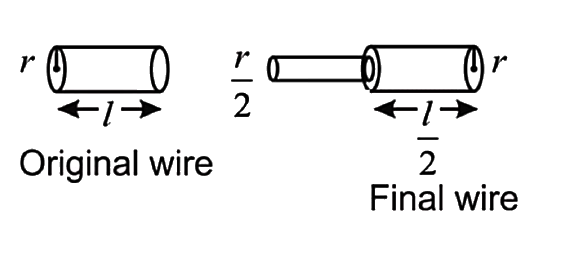A wire of mass m length I, density d, and area of cross section A is stretched in such a way that is length increases by 10% of its original value, Expresss the changed resistance in percentage.
To solve the problem step by step, we will follow the reasoning laid out in the video transcript.
Step 1: Identify the original length and the change in length
The original length of the wire is denoted as L. The wire is stretched such that its length increases by 10% of its original length. Therefore, the new length L′ after stretching can be calculated as:
L′=L+0.1L=1.1L
Step 2: Write the formula for the original resistance
The resistance R of a wire is given by the formula:
R=ρLA
where:
- ρ is the resistivity of the material,
- L is the original length of the wire,
- A is the cross-sectional area of the wire.
Step 3: Write the formula for the new resistance
After stretching, the new resistance R′ can be expressed as:
R′=ρL′A
Since the cross-sectional area A remains the same, we can substitute L′ from Step 1:
R′=ρ(1.1L)A=1.1ρLA
Step 4: Calculate the percentage change in resistance
To find the percentage change in resistance, we use the formula:
Percentage Change=R′−RR×100
Substituting the values of R′ and R:
Percentage Change=1.1ρLA−ρLAρLA×100
Step 5: Simplify the expression
Now, we simplify the expression:
Percentage Change=1.1ρL−ρLAρLA×100
This simplifies to:
Percentage Change=(1.1−1)ρLρL×100=0.1ρLρL×100
The ρL terms cancel out:
Percentage Change=0.1×100=10%
Final Answer
The change in resistance is 10%.
---
The original length of the wire is denoted as L. The wire is stretched such that its length increases by 10% of its original length. Therefore, the new length L′ after stretching can be calculated as:
The resistance R of a wire is given by the formula:
- ρ is the resistivity of the material,
- L is the original length of the wire,
- A is the cross-sectional area of the wire.
After stretching, the new resistance R′ can be expressed as:
To find the percentage change in resistance, we use the formula:
Now, we simplify the expression:
The change in resistance is 10%.
Topper's Solved these Questions
- ELECTRIC CURRENT AND CIRCUITBook:CENGAGE PHYSICS ENGLISHChapter:ELECTRIC CURRENT AND CIRCUITExercise:Solved Examples
Explore 12 Videos
- ELECTRIC CURRENT AND CIRCUITBook:CENGAGE PHYSICS ENGLISHChapter:ELECTRIC CURRENT AND CIRCUITExercise:Exercise 5.1
Explore 28 Videos
- ELECTRIC CURRENT & CIRCUITSBook:CENGAGE PHYSICS ENGLISHChapter:ELECTRIC CURRENT & CIRCUITSExercise:Kirchhoff s law and simple circuits
Explore 15 Videos
- ELECTRIC FLUX AND GAUSS LAWBook:CENGAGE PHYSICS ENGLISHChapter:ELECTRIC FLUX AND GAUSS LAWExercise:MCQ s
Explore 38 Videos
Similar Questions
Knowledge Check
A wire of length L and area of cross-section A, is stretched by a load. The elongation produced in the wire is I. If Y is the Young's modulus of the material of the wire, then the force constant of the wire is
AYLABYlACYALDYAl
A wire has a resistance of 10Ω. It is stretched by 1/10 of its original length. Then its resistance will be
View SolutionThe resistance of a wire is 10Ω. Its length is increased by 10% by stretching. The new resistance will now be
View SolutionThe area of cross section of a uniform cylindrical conducting wire is decreased by 20% due to stretching it. The percentage change in its resistance is (approximately)
View SolutionA wire of length l has a resistance R. If half of the length is stretched to make the radius half of its original value, then the final resistance of the wire is

View SolutionWhen the length and area of cross-section both are doubled, then its resistance
View SolutionThe wire is stretched to increase the length by 1%. Find the percentage change in the resistance.
View SolutionConsider a wire of length l , area of cross-section A and resistivity ρ and resistance 15Ω. Its length is increased by applying a force on I and its length increases by four times of its original length. Find the new resistance in ohms of the wire.
View Solution